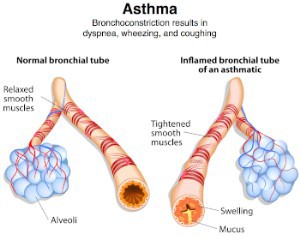Study Explores Anti-Asthmatic Effects Of Moxibustion

Moxibustion, or "moxa", is a widely utlizied adjunctive technique in Chinese Medicine. It involves the burning of an herb, ai ye ("mugwort") on or near the skin at certain points or above certain areas based on symptoms. A general introduction can be found in my "What Is Moxibustion?" article.
Moxa is most often used for strengthening the body and/or resolving what we term stagnation in Chinese Medicine theory. A simple case would be a acute injury with bruising, i.e. an external usage. Then there are strong benefits to the immune system and overall physical strength using a point such as zu san li ("ST 36"). With certain points, there are very precise internal changes such as reductions in the inflammatory underpinnings of ulcerative colitis (relevant study). And, then, probably one of the more well known usages, turning a breech baby.
Generally speaking the internal effects from moxibustion seem to be broader and more significant in many cases than seems likely given the relatively basic approach. While there have been many studies looking at some of working mechanisms, it is far from completely explored in western scientific terms. One usage that at times even seems counterintuitive due to the relatively smoky nature of the process is asthma.
It is this usage with asthma that brings us to the study that I will be exploring today. While asthma involves a complex interplay of internal and external factors in essence there are a host of inflammatory markers that are generally involved (a deeper exploration of these mechanisms can be found here, and here). The tl;dr of these studies is that "asthma is not a single disease, but rather a syndrom that can be caused by multiple biologic mechansisms". Beyond the reach of this article, but this hints at the needs for more systemic treatment such as that offered by Chinese Medicine as a whole (i.e. acupuncture, herbal medicine and moxibustion when appropriate) rather than symptomatic management as is more common in western medicine.
That aside, researchers from the Hunan University of Chinese Medicine recently conducted an animal study to deeply explore the working mechanisms of acupuncture on a critical point for lung function, the "lung shu" point UB 13. Moxabustion was applied bilaterally on UB 13 to asthma induced rats 15 minutes daily for 2 weeks.
The researchers found that the moxibustion treatment group had "significant decreases" in:
- Inspiratory and expiratory resistance
- Cutaneous histamine - a central mediator released from mast cells through allergic reactions, plays a role in airway obstruction via smooth muscle contraction, bronchial secretion, and airway mucosal edema.
- Substance P - neurokinin substance P acts by binding to neurokinin-1 receptor (NK-1R), increasing airway smooth muscle cells (ASMC) which are related to airway remodeling and hyper-responsiveness. Will be up-regulated in asthmatics during an inflammatory response.
- Calcitonin gene-related peptide - Calcitonin gene-related peptide is a potent vasodilator and is usually up-regulated in the airways of asthmatics during an inflammatory responses.
and "significant increases" in:
- Lung ventilation compliance
- Cutaneous vasoactive intestinal peptide - seen throughout the cardiopulmonary system, involved in a range of functions including potent vascular and airway dilatory actions, potent anti-inflammatory actions, improving blood circulation to the heart and lung, and modulation of airway secretions
They concluded that "moxibustion of BL13 can improve pulmonary function ... which may be related to changes of levels of histamine and neuropeptides ... in the local skin tissues of BL13".
Now from a treatment perspective, to truly deal with the underlying mechanisms of asthma, you need to treat quite broadly in Chinese Medicine diagnostic terms and take into account diet, environment, and even emotions and stress levels in many cases. But to a properly tailored treatment approach overall, moxibustion may be a warranted addition.
tag @yinyanghouse for questions/comments